Deborah J. Ross's Blog, page 41
March 8, 2021
Guest Post: Deborah Grabien Says Rock and Roll Never Forgets
How I Accidentally Brushed George Harrison’s Hair
By Deborah Grabien
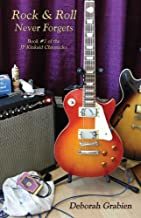
Since this is going to be all about interweaving real world Rock And Roll Hall Of Fame musicians with fictional musicians in a fictional band at the same level of stardom, let me throw this out there: Back in the day, just as 1970 was officially becoming 1971, I accidentally spent fifteen or so minutes playing with George Harrison's hair.
Yes, that that actually happened. And yes, there's a story in there, but it's not the story I want to tell, here. Nor is this simple name-dropping. What it does do is to hint at why, when writing fiction about a very public profession—in this case, a world-famous guitar player—the occasional presence of the actual real-world stars of that profession is inevitable.
In my day, I wrote—among many other things—two mystery series with music and musicians at their core. The first series, the Haunted Ballads, had a traditional Scots guitarist Ringan Laine and his theatrical troupe leader girlfriend Penny Wintercraft-Hawkes as the protagonists. In those, I learned how to be comfortable letting some of the genuine stars of British trad music filter through into my fictional setting. There were mentions of Ringan's band switching start times at a festival show with "Martin and Dave." I suspect most readers of the Haunted Ballads knew that I was talking about Martin Carthy and the late Fairport Convention fiddler, Dave Swarbrick. I did get some fan mail asking who some of the names belonged to. I still take pride in being able to steer them towards the legendary bands of that musical genre.
But the need to move actual musicians in and out of my own fictional universe really came with the JP Kinkaid Chronicles. John Kinkaid, when we meet him in the first of the eight Chronicles, is in his mid-fifties. He's an English ex-pat, who has lived in San Francisco for 25 years with his life partner, Bree Godwin. Like me, he's a guitarist with multiple sclerosis; those two things, music and MS, are not happy bedfellows.
JP is a touring musician with Blacklight, a fictional band roughly as successful, and nearly as long-lived, as the Rolling Stones. And since JP's voice is the voice of my own first love, legendary pianist Nicky Hopkins, some of JP's memories and experiences are drawn from the few years I spent doing very much what Bree does: being fierce about his health and safety, not wanting to step out of the shadows to do real shows (like JP, Nicky was unhappily married at the time), and just wish all this rock star stuff would disappear and leave me alone with him. But the reality is that, if JP is touring and recording at that level of stardom, he's going to interact with some real world legends.
It's tricky. For one thing, I have to be true to how the character would see, feel, speak, react. Since JP is narrator, he's not going to say "oh, yeah, then Heart came out and jammed with us." He wouldn't think that way. The band's official blogger might, but JP wouldn't.
So I took it on this way. From "Dead Flowers", Kinkaid #7. Bree is reacting hard to the woman fronting the opening act for JP's side band, The Fog City Geezers. And JP thinks she's jealous. As it turns out, she is, but he has the reason wrong, at least at first:
"I didn't say freaked out, did I? I didn't say scared, either." We were eye to eye again, just enough moonlight to see what was happening in her face, and this time, I was keeping my voice even. "I said jealous. And yeah, I said nuts. Crikey, Bree, you'd have to be, to not trust me after all this time. So she plays a Les Paul, so what? You didn't lose it like this when we played with Heart, back on the Book of Days tour. Nancy Wilson didn't flip your switches, and if we're talking about a hot chick who knows her way around a Les Paul, she's the gold standard. So what the hell is the real story here? Because I don't buy that this is about Elaine Wilde being a musician, you know? Not unless you're jealous of that kid, as well."
Nancy Wilson of Heart isn't just dropped in as a famous name. She's there, she exists, but the only reason she exists at this moment in time in the Kinkaid story arc is because something about who she is, and what she does, is having an effect in JP and Bree's world. She's never extraneous. There's a reason for her to be there, a reason for her to impact the characters. The reason for Bree's personal panic has nothing to do with the opening act, however. The reason, which JP suddenly realises a moment later, is in fact the opening act's child.
Another moment, this time from Kinkaid 5, "Book of Days." Blacklight is about to take the stage for two songs during the Super Bowl halftime show. One of the two songs, "Liplock," is very dirty indeed, and the network censors have their knickers in a twist. Mac, Blacklight's lead singer, as they're waiting to go onstage to a global audience of about a billion viewers:
"It had taken one short band meeting - five minutes - to decide what we wanted to do. We opened with "Liplock," five minutes of high intensity, every damned note of it aimed straight at the groin. When we'd first told the NFL people what we wanted to play, they'd had a look at the lyrics and started making the sort of noises I'd have associated more with nuns. Ian came back to us and said they were flipping their shit over it, we pointed out that the Stones had covered "Rough Justice" as part of their twelve minutes, and that the programming puritans might want to check out the lyrics to that one. Good call, since the song's got lyrics suggestive enough to have made them squirm."
The Glimmer Twins become part of the moment again, same context, when the network tries to convince Blacklight to use a canned rhythm track and have Mac lipsynch, to make sure they don't exceed their twelve minute time allotment:
So for me, it's not about putting real life celebrities into a fictional stories. It's about making sure, as the writer of a series about high end rock and roll, a writer who's lived a lot of it since 1968, that I seamlessly integrate them into my characters' world. As you read, it's simply a fact of life for a legendary band like Blacklight: they know everyone, because everyone at a certain level of the industry does, in fact, know everyone else. The man John Kinkaid gives voice to is the piano you hear on the Stones' "She's A Rainbow," "Gimme Shelter," "Angie." It's the second piano, side by side with John Lennon, on "Imagine." It's "Jealous Guy" and Joe Cocker's "You Are So Beautiful." JP began as a session player and became a world famous superstar. So he's worked with pretty much everyone, and knows them. The entire band does. They aren't celebrities to JP or Mac or anyone else in the Blacklight families. They're peers, musicians, singers, songwriters, colleagues and - in many cases - friends. Many of the people JP knows, I also know. But the only time their fame becomes something I have to look at is when we're trying to juggle schedules. Otherwise, it simply isn't relevant. These are people I know, and in many cases people I've co-written songs with or who've recorded with my band (David Lindley, for one)."Here we go." Stu had come up beside me, flexing his wrists, getting ready. He had a pair of sticks, just moving them about, limbering up, getting his hands turned on. "Good thing Ian didn't cave on that pre-recorded rhythm section shite. I'd have stayed home and slept in, instead."
"Yeah, that was completely barmy." I had to raise my voice; the crowd was beginning to really make noise. "I just loved the excuse, didn't you? How it was all split-second timing, and forcing the band to synch up with a pre-recorded rhythm section would make us stick to the time limit? Surprised they asked us to play, if they thought we were such amateurs. Shit, we've been together, what, thirty plus years, and they honestly think we can't structure a bleedin' set to end at twelve minutes? I wonder if they tried that rubbish on the Stones?"
"I'm even more curious about what Mick told them, if they did. I'll have to ask him, next time I see him. Or Keith." Mac was bouncing, foot to foot. "Come on, people, it's showtime, just bloody announce us, will you please...?"
Having your fictional characters moving on the top tier of touring music stardom means that both your fictional characters and the artists inhabiting that same space in the real world are going to interact. My job, writing those moments, writing the entire series, was not to leave the reader thinking "oh, wow, Mick Jagger!" My job was write it so seamlessly that, while watching a Stones video on YouTube, my reader has at least one moment of wondering if JP is in the band room, getting ready to sit in.
It's only rock and roll. And in the band rooms and bedrooms and hotel rooms of the Kinkaid Chronicles, rock and roll really never forgets.
Deborah Grabien can claim a long personal acquaintance with the fleshpots—and quiet little towns—of Europe. She has lived and worked and hung out, from London to Geneva to Paris to Florence, with a few stops in between. But since her first look at the Bay Area, as a teenager in 1969, she’s always come home to San Francisco. She was involved in the Bay Area music scene from the end of the Haight-Ashbury heyday until the mid-1970s. Her friends finally convinced her to write about those years—fictionalised, of course! The result is the critically acclaimed eight-book JP Kinkaid Chronicles.
Deborah and her husband, San Francisco bassist Nicholas Grabien, have their own trio, The Sound Field (with Larry Luthi on drums). The band's second CD is due out 1 March 2021. Both CDs have featured guest appearances from rock music luminaries, both local and international. These days, Deborah can be found playing music and writing music or writing about music, insofar as multiple sclerosis - she was diagnosed in 2002—will allow.
Find her CDs, the JP Kincard Chronicles, and much more at Plus One Press.

March 5, 2021
Book Reviews: The Brutal and Hopeless Beauty of Ballet
Bright Burning Stars, by A.K. Small (Algonquin Young Readers)
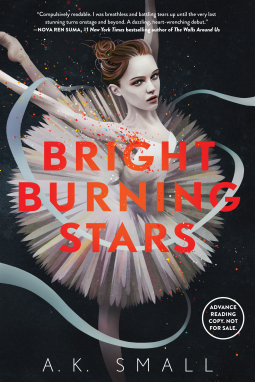 Ballet, for all its ethereal beauty, is brutal physically and even more devastating emotionally as young dancers distort their bodies and vie with one another for the precious few openings that lead to stardom. Nowhere is this pressure-cooker atmosphere more evident than in the boarding schools that feed dancers into prestigious companies. Bright Burning Stars examines the price of such success and asks whether a friendship can survive it.
Ballet, for all its ethereal beauty, is brutal physically and even more devastating emotionally as young dancers distort their bodies and vie with one another for the precious few openings that lead to stardom. Nowhere is this pressure-cooker atmosphere more evident than in the boarding schools that feed dancers into prestigious companies. Bright Burning Stars examines the price of such success and asks whether a friendship can survive it. The story centers on two young women in their final year at the Paris Opera Ballet School. Kate and Marine have been inseparable, best friends, declaring that if they cannot both receive the coveted Prize, neither will have it. As the year progresses, however, pressures mount. Marine, still unable to come to terms with the death of her twin brother who was her inspiration in ballet, descends into anorexia. Kate throws herself into an infatuation with the charismatic senior male dancer, with the result of an unintended pregnancy. Instead of drawing Kate and Marine closer for support, each turn for the worse only seems to widen the gulf between them.
The strengths of the story include strong, flowing prose; engaging characters that change and grow; a vivid depiction of a world that few outside the profession of ballet ever experience; a passionate portrayal of the sensual glory of ballet as an art form; and keen insight into the psychological and physical stresses on dancers. These are significant strengths, indeed, enough to captivate the reader. The narrative kept me turning the pages and caring about the fate of Kate and Marine.
On the down side, watching the two main characters slide into mental illness (for example, eating disorder, severe codependence, obsession, suicidal ideation) was unrelentingly grim. The absence of adult supervision and care was exemplified by the scene, late in the book, where Kate goes to the director with concerns about Marine’s life-threatening symptoms and is essentially blown off and accused of trying to eliminate a rival.
Either these young women are particularly dysfunctional or else the entire realm of ballet is remarkably deficient in healthy relationships. That much I could buy, however, and even the way the school encourages toxic competition at the expense of the health of its students. What was less believable was the ease with which Kate and Marine turned their lives around. Both suffer from serious disorders, neither receives competent psychotherapy – or any counseling at all – and yet a simple “realization” seems sufficient to resolve their problems.
Personal soapbox rant: Eating disorders are among the deadliest mental illnesses. A study by the National Association of Anorexia Nervosa and Associated Disorders (ANAD) reported that 5-10% of anorexics die within 10 years after contracting the disease and 18-20% of anorexics will be dead after 20 years. Relapse rates over 18 months run between 35 and 41 %.
Issues like eating disorders and obsessive reliance on the attention of others to bolster poor self esteem do not magically disappear because of a few compliments from a peer; they require skillful management over a period of time. Most of all, the person herself must recognize that something is wrong, that she wants to get better, and that she needs help to do so. This is not to say that relationships play no part in recovery, only that with conditions this severe – as evidenced by a suicide attempt – they are not sufficient in themselves. In many ways, these girls are still children; they need adult intervention.
Storytelling is a powerful tool for recovery, and as an author I see every story as an opportunity to share hope, understanding, and compassion. Quick fixes offer none of these. Bright Burning Starsis not necessarily about how mental and physical health can be regained, but I cannot help contrasting it to the all-too-few books that show a realistic path forward. (Two stellar examples are a character with social anxiety disorder in The Calculating Stars by Mary Robinette Kowal, and one with PTSD in Lia Silver’s Laura’s Wolf.)
A sympathetic character takes the reader on a journey, an adventure seen through that character’s eyes. This identification makes for a vivid reading experience but also imposes a degree of ethical responsibility on the author. Actions – such as aborting a pregnancy with untested and hazardous herbs, as Kate does – have consequences. This is not to say that characters cannot make bad choices or that the author must then lecture the reader about why those choices are bad. The problem here is that Kate doesn’t learn anything from her risky choice. She isn’t any more responsible about sexual activity than before, and she doesn’t gain any insight into her own proclivity for all-devouring infatuation that masks her deeper problems. Likewise, Marine never faces her eating disorder or its cost. The message to the young reader is that no emotional work is required for a happy ending, and also – more dangerously – that there is no help from adults. It’s typical in YA literature for adults to be absent, supposedly to give the young people agency. But Marine’s anorexia, as portrayed, is severe enough to require hospitalization, or at least to have that conversation.
I was also disappointed to not find any references to support resources, either within the story itself or in an appendix. So I’ve put together a few here.
To the readers and their families: If you, or anyone you know, has an eating disorder, a serious emotional dependence upon others, or has thought about or attempted suicide, please take it seriously. Know that you are not alone, and that there is help. Here are a few places to start:
National Eating Disorders Association: https://www.nationaleatingdisorders.org
https://www.mayoclinic.org/diseases-c...
National Alliance on Mental Illness: https://nami.org/Home
Co-Dependents Anonymous: https://coda.org/
Teen suicide prevention resources: https://youth.gov/youth-topics/youth-suicide-prevention
https://suicidepreventionlifeline.org/
https://www.apa.org/topics/teen-suicide-prevention
Addendum: After I wrote this review, I read Abi Stanford’s from September 2020 blog in Dance Magazine. As a professional dancer who has struggled with mental illness, she makes a passionate statement for a more human, supportive ballet culture.
I have lived and performed with (sometimes crippling) anxiety for my entire career, and I'm nowhere near the only one who's struggled. I know of a dancer who picked up her bag and quit in the middle of a rehearsal. One time a young dancer timidly asked a group of older dancers whether ballet company life was hard for them. Upon emphatic replies of "yes," he said, "I thought it was just me. Everyone walks around like they are just fine."
Dancers feel immense pressure from management to constantly be perfect onstage. Yet, we are at the mercy of our bodies. Those two factors are an excellent recipe for anxiety. Some dancers cry a lot. Others call out sick when they're too anxious to perform. Some even choose to retire altogether—far too young.
There needs to be more mental health support within dance companies. Psychological services should be made available to all dancers and artistic staff—including ballet masters. At my company, they're under an intense amount of pressure to prepare the vast repertory, and all are former NYCB dancers who shared similar experiences, stresses and pain during their own careers.
Overall, everyone needs to listen more. Artistic management could send out anonymous surveys to assess what areas need improvement. Companies could hold talk-back sessions with dancers to open up the lines of communication about what's working and what's not. We need to make it acceptable for dancers to take care of their mental health. We need to stop training dancers (explicitly and implicitly) to hide their anxiety for fear of losing performance opportunities.
It is time to begin the conversation, because I worry about the ongoing suffering of dancers if this is not addressed. I worry that company leadership will continue to view my very real struggles with my mental health as a weakness. Most of all, I worry that the next generation of artists will continue to suffer as too many of their predecessors have.

March 3, 2021
Today's Jane Austen Quote
 Jane Austen by her sister, Cassandra“There is no charm equal to tenderness of heart.”
Jane Austen by her sister, Cassandra“There is no charm equal to tenderness of heart.”– Jane Austen, Emma

March 1, 2021
[shameless self-promotion] Tanja Nathanael Reviews Collaborators
Here's what literary scholar Tanja Nathanael says about Collaborators:
A deeply sympathetic portrayal from my friend and author Deborah J. Ross of the havoc that ensues when a damaged Earth ship arrives on an alien world. Misunderstandings and tragedies occur on both sides as a result of language and cultural differences. Most especially convincing, the Bandari--the feline gender fluid native population of the planet--are deftly constructed in terms of their biological, emotional, intellectual, and political motives. Like all good #scifibooks , Collaborators engages with the ethics of alien encounters and the consequences of making assumptions based on one's own limited world view.
Buying information:
Amazon(ebook and trade paperback)
B & N (ebook, trade paperback, and hardcover/laminated cover)
Ingram: (for your local bookstore orders)
Trade paperback: 9781952589003
Hardcover/dust jacket: 9781952589027Also available from GooglePlay, Apple, and Overdrive

February 26, 2021
Short Book Reviews: Magical Hands as a Tool of Racial Justice
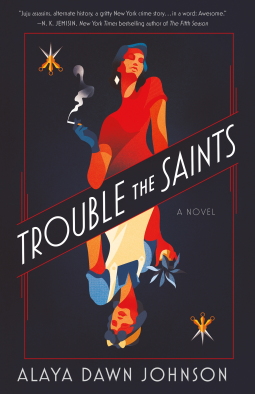
Trouble the Saints, by Alaya Dawn Johnson (Tor)
The core of the magic in this edgy, often disturbing fantasy is that the anguish of slaves was so deep, so powerful, that it created a spell persisting to the modern age. This takes the form of bespelled hands – hands that can detect a person’s darkest secrets, hands that can tell the future – and hands that crave justice. In 1940s New York, the descendants of those slaves, men and women gifted with magical hands, often end up on the wrong side of the law. Phyllis, the first of these characters, is an enforcer for a white mobster, his “avenging angel.” Her best friend, Tamara, dances with a snake and tells fortunes at the mobster’s night club. And Dev, who loves them both, is a bartender by night and police informant by day. But someone has been targeting Blacks and harvesting their hands…
Trouble the Saints is a difficult book to describe. It’s not an easy or comfortable read, but it is an important book, fearlessly delving into issues of racism, injustice, murder, greed, and forgiveness.

February 22, 2021
Creating Characters in a Shared World
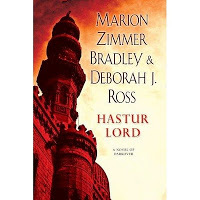
One of the most challenging aspects of continuing Marion Zimmer Bradley’s Darkover series--or any world invented by another author, for that matter--has been the portrayal of characters that are not my own. Most were created by Marion herself, but some came from one or another of the writers she had worked with before me. A case in point is Marguerida Alton, who began as a small child in Marion’s books but was brought to adult life, much to the delight of many readers, in the Darkover novels written by Adrienne Martine-Barnes.
To begin with, writing someone else’s characters is a no-win situation. No matter how carefully you, the new writer, study what has been done before, pouring through notes and out-takes and letters as well as published material, you’re going to get something wrong. Or perhaps not wrong but different. This is primarily because we are all individuals. Each creative vision, each way of working with characters, is unique. Added to that are the variations inherent in each story.

A novel is like a character unto itself, and plot and theme interact with character. Most writers have had the experience of realizing that a character is wrong for this particular story (or vice versa) or of a secondary character who keeps trying to run away with the story and has to be bribed back into submission with promises of a future story all her own. For example, the character of Regis Hastur evolved over decades and through a number of novels. This was partly because Marion’s conception of Darkover and the people on it had matured, but also because each story required a different view, even of the same character.
When I sat down to write about Regis Hastur in Hastur Lord, I asked myself which version of Regis and which aspects of Regis were necessary for the story at hand. Which incarnation would bring the right anguish, the passion, the integrity, the insecurity, and the instinctive gift for leadership?
To do this, I drew not only on the published novels in which Regis played a role, but on Marion's short stories, notes and personal communications. I was working from a partial manuscript that Marion wrote in the final year of her life, which furnished the skeleton of the plotline, as well as some new characters.
My editor at DAW Books is Betsy Wollheim. Betsy not only edited Marion herself, but her father, Don Wollheim, was Marion’s editor at Ace, so the father-daughter editorial team has been part of the unfolding story Darkover from the beginning. Betsy was able to give me not only specific information about the history of Regis and Danilo, but an editor's perspective on Darkover. Ann Sharp, the Trustee of the Marion Zimmer Bradley Literary Trust, and Marion’s secretary, Elisabeth Waters, also furnished invaluable insights into how Marion saw these and other characters. Finally, the manuscript was reviewed and approved not only by the Trust but by DAW’s own in-house Darkover maven, Marsha Jones.
Once a character-written-by-someone-else has made it into a published story, however, a sort of feeding frenzy begins. As uncomfortable as it sometimes is to be on the receiving end of criticisms from readers who are furious that their favorite characters are being misinterpreted, I applaud their passion and loyalty. I believe that we fall in love with characters who reflect and inform the deepest stirrings of our own hearts, no matter who originally wrote them.
A version of this blog appeared in 2011.

February 19, 2021
Short Book Reviews: My Introduction to Rebecca Roanhorse's Work
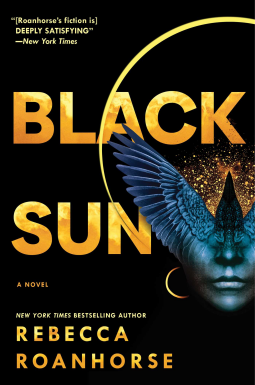
Black Sun, by Rebecca Roanhorse (Saga)
This novel was my introduction to the work of Rebecca Roanhorse, of whom I had heard a great deal. From the beginning, I was struck by the originality of her world and cultures that were at once relatable and quite different from the typical Western-European-derived canon. Set in a fantasy pre-Columbian (or non-Columbian?) Central America, the story weaves together the lives of disparate characters, who will all come together at “the Convergence,” a predicted eclipse. The story is told from multiple points of view, jumping back and forth in time. This is often a recipe for reader confusion and disengagement, but I found the characters compelling enough to hold my interest and to welcome each new section. I found the jumps in time distracting and largely unnecessary, but I admit to a personal preference for chronologically linear stories. In the end, though, it was the novelty and richness of the world that enchanted me.

February 15, 2021
Yet Another Evacuation, The Report
I live in the mountains in a redwood forest in Central Coast California. I love this place and the deep serenity it has brought me. But there’s a down side to every locale, and wildfires are part of the ecology of this region. Much of the plant life, including redwoods, has evolved to survive and even thrive with periodic conflagrations. Humans, on the other hand, aren’t too fond of having their homes burned down, so they put out little fires, allow underbrush to build up, and are loathe to control flammable invasive species (like broom). Increasingly long, hot, dry summers that are the result of climate change turns the region, like many in the West, into a tinderbox. Last summer’s freak lightning storm ignited thousands of small fires that merged into huge ones. I’ve written earlier about my experience being evacuated and watching, day by day, as fires engulfed this area but the heroic efforts of fire fighters spared my own street.
Almost as soon as the mandatory evacuation orders were lifted, local authorities began an campaign of education and preparation for the next phase of this rolling disaster: debris flows. Debris flows are a type of mudslides.
Debris flows … are fast-moving downslope flows of mud that may include rocks, vegetation, and other debris. These flows begin during intense rainfall as shallow landslides on steep slopes. The rapid movement and sudden arrival of debris flows pose a hazard to life and property during and immediately following the triggering rainfall.1
In other words, debris flows are rivers of cement 15 or more feet high and moving at up to 40 mph. If you can see it, it’s too late. There’s no way to prepare except to get out of the way. Debris flows caused massive property damage and over 20 fatalities in 2018 in Montecito, Southern California. Our local agencies were understandably concerned.
We all studied the maps of debris flow risk and watched the weather forecast. November and December passed with only occasional gentle showers, well belong the threshold for triggering a debris flow. Some of us began to relax, hoping for a dry “La Niña” year. Old timers warned that often the real rains don’t set in until January. They were right.
We watched the approaching storm in the extended weather forecast. It became apparent this was no shower but an atmospheric river, capable of parking itself over our region and dumping inches upon inches of rain.
Although our side of the block wasn’t burned, the fire swept down the top of the ridge on the
other side of the street, coming down to the street in places. Across from our carport, a small paved road rises in a V, the slopes of which were burned but have been hydroseeded. The redwood trees all survived, many with charred trunks but new growth from their roots and crowns. California oaks also fared well, and their deep tap roots are great for stabilizing hillsides. I concluded that our property would likely fare well, with muddy floors at worst, but that the streets at either end of our block were at risk of being closed and we’d be cut off. Okay, evacuation it is.
I’d already begun preparations by researching hotels (and concluding that despite the distance, it was cheaper and more comfortable for us to return to the extended-stay hotel where we stayed for 3 weeks last summer), attempting to desensitize the cats to their carriers, using up food in the freestanding freezer (and replacing it with gallon milk jugs filled with water, so that if we lost power, the freezer would stay cold longer), and so forth. I placed the checklists I’d made last summer on the kitchen counter.
Although the sky was still blue, the county issued an evacuation warning while the storm was still a couple of days out. We watched as the atmospheric river headed our way. When the mandatory order came, giving us 24 hours before the storm was expected to hit, I called the hotel, reserved a suite, and we began packing. While I was loading my car, deputy sheriffs came by, going door to door. “Are you staying?” they asked. I pointed to the open trunk and suitcases therein. “On our way out.” “Good!” We learned later that they were asking anyone not planning on evacuating to sign a waiver. Some folks in my neighborhood didn’t leave. Eventually everyone on my block did, and we all kept tabs on one another through social media, as we did during the fires.
We settled into our hotel and waited. The atmospheric river curved south, pummeling our area but hitting hardest in Monterey County, particularly Big Sur, where it swept away a section of Highway 1. Still, those locals who stayed reported “a wild night” of high winds and downpours. Luckily, they didn’t lose power or internet. Everyone worried that the downpour would saturate the burn scars and then even a light rain might cause slippage or flows.
This didn’t happen.
We returned after the mandatory order was changed to a warning (which has still not been lifted), to find our house intact and no more than a bit of extra mud and debris from the tiny street. The asphalt berm we’d installed in back of the carport had done a splendid job of guiding the water into the culvert just north of us and away from our house.
Discussions ensued. Had the agencies been hasty in ordering the evacuation? Had it been truly necessary? So many of us were suffering now from evacuation exhaustion on top of pandemic fatigue. Given how well our region fared, many questioned using the Montecito event as a model.
Those southern mountains are covered in chaparral, while ours are covered in redwood trees. The rocks are different, even the storms are different, Finnegan explained. There are many reasons why the current models don’t perfectly capture the dynamics of how debris flows will get started in the Santa Cruz Mountains.2
So here we are, having settled back in. The suitcases are unpacked, the cats once more in their familiar domicile, but in some ways things are less certain than before. We’d decided to obey an evacuation order. It turns out, we didn’t need to. How will we evaluate the next one, if it comes? Make a judgment about the storm ourselves? Look at how, if at all, the relevant agencies have shifted their protocols in response to this last storm? How to weigh the cost and exhaustion (not to mention lost school/work time and 4 irate cats) versus the perceived debris flow risk?
Stay tuned. Our neighbor is renting a backhoe to widen and deepen the culvert. Sandbag barriers are sprouting everywhere. We’ll see what the next months bring…
1. https://www.slvwd.com/customer-resources/pages/post-fire-preparedness-resources
2. https://lookout.co/santacruz/environm...

February 12, 2021
Short Book Reviews: Mystery, Mayhem, and Magical Sigils
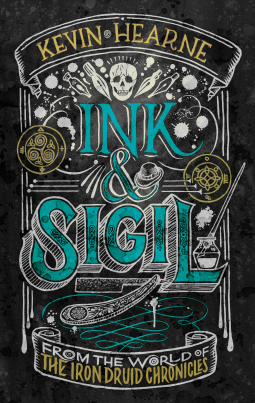
Ink & Sigil: From the world of The Iron Druid Chronicles, by Kevin Hearne (Del Rey)
A delightful, stand-alone book and introduction to a whimsically wonderful system of magic, complete with supernatural beings and Glaswegian (that’s Glasgow-ian) accent. Not to mention its pervasive sense of raunchy humor. Before getting started, the author provides an introduction with pronunciation and dialect guide. I found the language hilarious, never mind the characters and plot, because when I moved to this (remote, forested) area, there was a pub a few miles out of town. The White Cockade (check your history for the meaning) was owned and bartended by a Glasgow émigré with an accent roughly equivalent to talking around bits of glass. The only way to understand him was to turn off the front part of your brain and let the words seep in through the back of your skull. Several minutes later, all would be made clear. Which resulted in interesting timing of conversation. Nice guy, though. Great cook of pub food.
So here I am in a first-person Glaswegian dialect narration, whooping with laughter and in general enjoying the story immensely. That’s pretty much all you need to know, other than there’s a reason why the Sigil Master’s apprentices keep dying of such causes as eating scones with raisins. To make matters worse, the above-mentioned Sigil Master has been cursed in such a way that if he speaks directly to a person long enough, they are seized by a sudden and violent hatred of him, no matter how loving or trusting their previous relationship was. Although Ink and Sigil swept through a page-turning climax to a most satisfying ending, I hope to see more of its characters.

February 5, 2021
Very Short Book Reviews: Orphans and Swordswomen and Haunted Houses, Oh My!
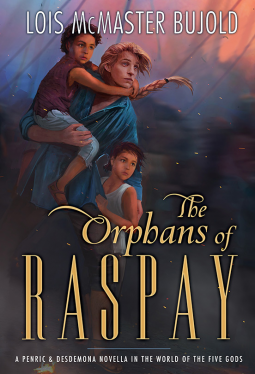
The Orphans of Raspay, by Lois McMaster Bujold (Subterranean)
Another Penric adventure! With pirates! Calloo callay!
Our stalwart cleric, host to the chaos demon Desdemona, is returning from a routine (read: tedious) mission when his ship is taken over by pirates. He and the rest of the passengers are to be sold as slaves at the nearest port, once free but now ruled by aforementioned evil-doers. While captive, he encounters two young girls destined for the same fate. While he is confident that he’ll either be ransomed or able to negotiate his freedom through his (and Des’s) penchant for persuasion, the girls have no such resources. Of course, he takes them under his protection, which complicates and lends special urgency to escape efforts.
I loved seeing new aspects of Penric, who is as resourceful and determined as evr, as well as watching his relationship with Desdemona evolve yet further. And really, Captured by Pirates is a great way to begin any story.
Burning Roses, by S. L. Huang (Tor.com)
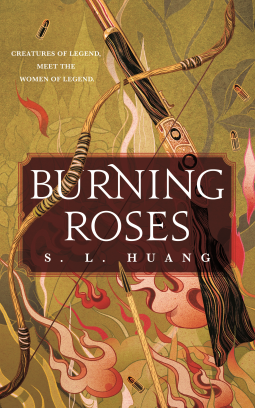
I loved S. L. Huang’s Null Set, which is science fiction (ish), with a heroine whose superpower is her genius at mathematics. Burning Roses takes us into the realm of fantasy with two aging women dragon hunters in a world in which humans can assume animal form, and distinguishing between them and true beasts poses critical moral questions. Each woman has her own tragic background, her own guilt, and her own path toward redemption. Rose, a European who came to this Asian-inspired land with her lover and daughter, has a long and tortured history through twisted fairy tales. The story pits the healing power of friendship against the crippling belief that one is beyond forgiveness. I loved the depth of the book, and also that the dragons are feathered, a bit like phoenixes. It’s not a long book, but one that should be read slowly, pondered over, and savored.
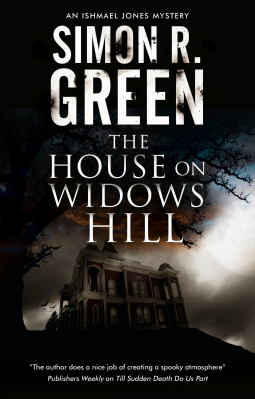 The House on Widows Hill, by Simon R. Green (Severn House)
The House on Widows Hill, by Simon R. Green (Severn House) Ishmael Jones, intrepid (and extraterrestrial) secret agent, takes on a haunted house, along with his charming companion, Penny. The story opens with a peek into Ishmael’s history, hints of the space ship crash that landed him on Earth and the existence of a second survivor. In return for help locating another of his kind, he agrees to investigate an old house with a nasty reputation. It’s the usual set-up, with Ishmael, Penny, and an assortment of psychics and ghost-hunters and such agreeing to spend an entire night in the house. Of course, spooky things happen. Of course, Ishmael and Penny don’t for a second believe these are due to supernatural apparitions.
Of course, things then take a seriously twisted turn, one even Ishmael can’t explain away.
The opening of the book felt comfortably familiar, with the legends and warnings about the house, the introduction and frictions between the guests, and the early, inexplicable events. But this is Ishmael Jones at work, and the story unfolds in the hands of a gifted writer who is much too savvy to follow expectations.
Marvelous fun, but with moments of reflection. I hope Ishmael gets his answers, but not too soon. The journey from here to there provides excellent entertainment.




